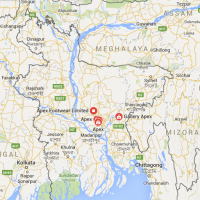Two Reviews on Local Footwear of Bangladesh

In Bangladesh two biggest festival are Eid-ul-Fitr and Eid-ul-Adha. Country’s people become disparate for shopping. Unlike dress people also buy at least one pair new shoes. From poor to richest everybody buy a vast number of new clothing items and so on.
Unlike clothing fashion footwear fashion did not bloom in newspaper or magazine. Country’s English newspaper The Daily Star had published two article about Bangladeshi Footwear market dated July 24, 2014 and July 04, 2015. The dates are almost one month earlier than Eid-ul-Fitr and Eid-ul-Adha.
On July 24, 2014 the paper reported that “Local footwear brands on a roll”- “The local market is huge and is growing tremendously. If we can offer quality products we will be able to stop the imports,” HAMKO said, adding that HAMKO is making 500 to 1,000 pairs of shoes a day for the local market only, with plans to treble the production by next year.
While the exact statistics on retail footwear sales are hard to come by, one estimate puts the annual sales figure at Tk 2,400 crore on the basis of per capita shoe consumption of nearly one pair.
Abu Taher, chairman of Bangladesh Finished Leather, Leather Goods & Footwear Exporters Association, said the local sales will total Tk 7,000 crore a year.
Meanwhile, a number of industry people say the home market, which has long been dominated by multinational Bata and local brand Apex and shunned by exporters producing high-quality wares for Western buyers is progressively becoming more attractive for footwear makers, as exports entail a lot of complexities.
Zaid Bakht, research director of the Bangladesh Institute of Development Studies, who conducted a study on the sector with colleague Nazneen Ahmed, said the domestic market is growing due to the efforts of small entrepreneurs.
He said the number of large footwear companies in the country is not huge, but entrepreneurs involved in the sector mostly own small industries scattered in Old Dhaka as well as around the country.
“If we can provide them with finance and space they will come out big, and can contribute to the local market in a huge way while also exporting.”
“There are producers whose designs are of good quality and are even selling them as products from China,” he told The Daily Star.
And On July 04, 2015 they also reported that “Shoe sales thrive ahead of Eid in Bangladesh” – A number of footwear manufacturers are expanding business networks, pinning their hopes on brisk sales ahead of the Eid.
Local sales of footwear hover between Tk 6,000 and Tk 7,000 crore a year, and 40 percent of the turnover comes during the Eid-ul-Fitr, said Abu Taher, chairman of Bangladesh Finished Leather, Leather Goods and Footwear Exporters Association.
Though the home market has been dominated by multinational company Bata and local brand Apex for quite long, several local companies have emerged in recent times seeking to tap into the growing domestic demand.
Cheap labour here could attract foreign investment. Political stability, business-friendly environment and low bank interest rates are essential for both local and foreign investment in this sector, he added.
According to data of the Export Promotion Bureau, Bangladesh exported leather, footwear and leather products worth $204.44 million from July to May in fiscal 2014-15. The amount was $205.03 million during the same period in the previous year.
Abu Taher, chairman of Fortuna Bangladesh, said high bank interest rates are a barrier to expansion of footwear business, as entrepreneurs need credit to expand their networks.
“We have 18 outlets that sell footwear and leather products. We have plans to expand the network across the country. But we need credit from banks,” he said, adding that the bank interest rate is around 15 percent in Bangladesh while it is only 3-4 percent in China.



